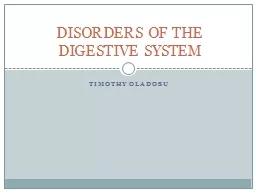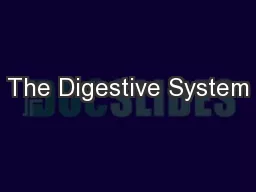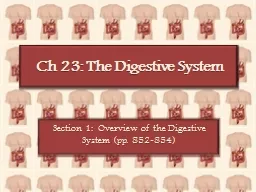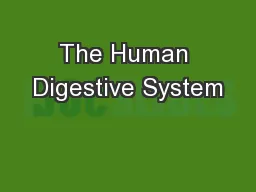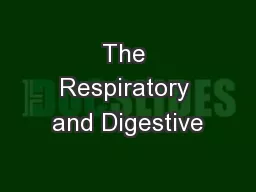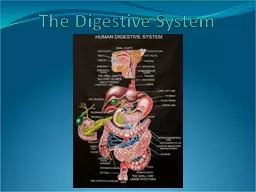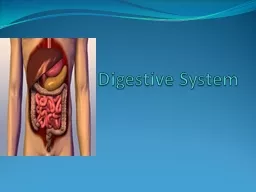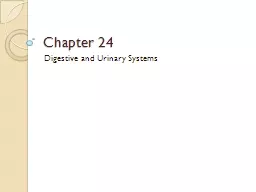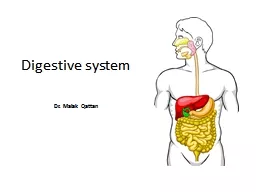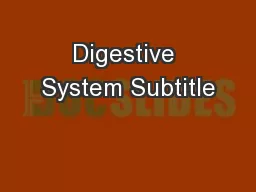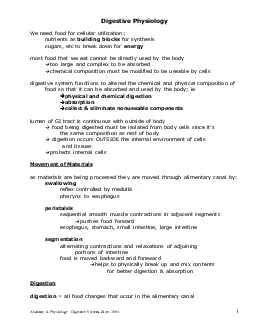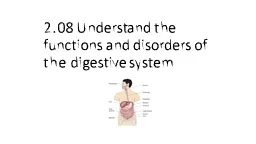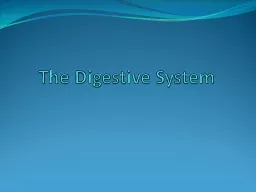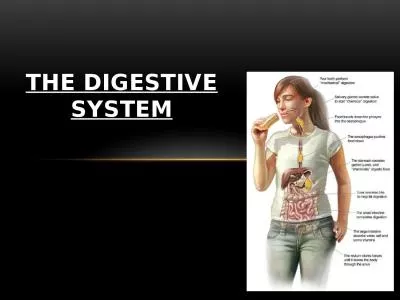PPT-TIMOTHY OLADOSU DISORDERS OF THE DIGESTIVE SYSTEM
Author : caitlin | Published Date : 2022-06-11
OUTLINE Overview of anatom y amp physiology Disorders of the mouth and esophagus Stomatitis Hiatal hernia amp reflux esophagitis Achalasia Diverticulum OVERVIEW
Presentation Embed Code
Download Presentation
Download Presentation The PPT/PDF document "TIMOTHY OLADOSU DISORDERS OF THE DIGESTI..." is the property of its rightful owner. Permission is granted to download and print the materials on this website for personal, non-commercial use only, and to display it on your personal computer provided you do not modify the materials and that you retain all copyright notices contained in the materials. By downloading content from our website, you accept the terms of this agreement.
TIMOTHY OLADOSU DISORDERS OF THE DIGESTIVE SYSTEM: Transcript
OUTLINE Overview of anatom y amp physiology Disorders of the mouth and esophagus Stomatitis Hiatal hernia amp reflux esophagitis Achalasia Diverticulum OVERVIEW OF ANATOMY amp PHYSIOLOGY OF THE DIGESTIVE SYSTEM. . and Muscular. Systems . By Blandy , Esmeralda , Misty , Alexis , Idaly. Digestive system. The digestive tract (also known as the alimentary canal) is the system of organs within multicellular animals that takes in food, digests it to extract energy and nutrients, and expels the remaining waste.. Lesson5– . Digestive System Model. Objectives. :. Students will gain a full understanding of how the digestive and excretory system work in their own . bodies.. Students will be able to name the parts of the digestive system.. Section 1: Overview of the Digestive System (pp. 852-854). Two groups of organs. :. . 1) . Alimentary. canal. . - also known as . gastrointestinal. or . GI. tract. . - . digests. & . What do you already know?. Complete the Digestive System Handout to the best of your ability without looking in any text or your notes.. You may work in groups.. Do not complete the bottom overview.. Systems Key. I. The . Respiratory System. Define . respiratory system.. The system that functions to get oxygen from the environment and remove carbon dioxide and other waste products.. I. The Respiratory System. The digestive system is used for breaking down food into nutrients . which then pass into the circulatory system and are taken to where they are needed in the body.. Introduction. There . are four stages to food digestion:. the human body systems . interact? . Today I will learn about the integumentary and lymphatic systems because both systems are responsible for protecting the human body from . disease. .. Fact or Fiction? (7 minutes). Chapter 24 Digestive and Urinary Systems Section 1: Objectives Compare mechanical digestion with chemical digestion. Describe the parts and functions of the digestive system. The Digestive System . Qattan. 2. The GI tract. . (gastrointestinal tract). . Mouth. Pharynx. Esophagus. Stomach. Small intestine. Large intestine. Anus. The accessory digestive organs. Supply secretions contributing to the breakdown of food. Bell Work. Please answer these “pre-test” questions:. 1) Which has a longer length – the large intestine or the small intestine?. 2) True or False: Digestion begins as soon as it enters the mouth. pharynx to esophagus all food changes that occur in the alimentary canalAnatomy Physiology Digestive System Ziser 2003breaking large molecules proteins fats starches etca thick coating of bicarbona 2.08 Understand the functions and disorders of the digestive system. Essential questions. What are the functions of the digestive system?. How do the functions of chemical and physical digestion interrelate?. continual supply . of water, electrolytes, and . nutrients.To. achieve . this requires . (. 1) movement of food through. the alimentary tract; (2) secretion of digestive juices. and digestion of the food; (3) absorption of water,. Ingestion: . The in take of food into the digestive tract through the mouth. Mechanical Processing: . The physical manipulation of solid foods into materials that are easier to propel through the digestive tract. Also increases the solid foods surface area which makes them more susceptible to enzyme activity and easier to absorb. .
Download Document
Here is the link to download the presentation.
"TIMOTHY OLADOSU DISORDERS OF THE DIGESTIVE SYSTEM"The content belongs to its owner. You may download and print it for personal use, without modification, and keep all copyright notices. By downloading, you agree to these terms.
Related Documents

